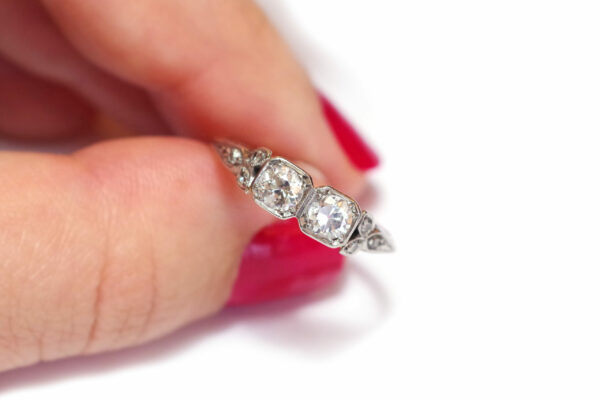French Art Nouveau necklace, with a little German jugendstil style with plique a jour enamel and imitation stones.
Edwardian Art Nouveau necklace
Description
Edwardian Art Nouveau necklace in gilted silver. The pendant takes a stylized floral form reminiscent of an orchid. It is made of blue and purple plique-a-jour enamel. Two garnet / glass doublets adorn the upper and central part in a beaded setting. Several marcasites decorate the pendant. A tassel pearl below the pendant. The chain is composed of fine mesh figaro. A floral element decorated with marcasite is attached to the chain. French jewel of the Art Nouveau period, goldsmith Adolphe Dupont, circa 1910.
Boar hallmark, goldsmith’s hallmark (active between 1901 and 1913).
Total length of the chain: 46 cm
Height of the pendant: 3.7 cm
Width of the pendant: 3,5 cm
Condition: cracks in the enamels without chips or missing pieces.
Weight : 10,38 gr
History point:in antique jewelry, the Art Nouveau period is characterized by the inspiration of fauna, flora and also of women. Jewelers of this period are particularly influenced by Japanese art. We often find the same subjects: the woman in profile, the butterfly, the foraging bee, the dragonfly, fantastic animals, the seahorse, the fish, etc. The most popular fine and decorative stones from this period are opal, moonstone, topaz, amethyst, agate, ivory and horn. Finally, enamel is used in all these forms, it offers an infinite range of colors and gives an interesting aspect to the jewel, like plaque a jour enamel.
Technical point:the plique-à-jour is an enameling technique very fashionable in the 19th century. Similar to the cloisonné technique, it consists in the application of enamels without a metallic background. In such a way that the enamelled jewel, once heated, lets the light in through its transparency or translucency and lets the colors bewitch the observer. To better understand, we could say that it is a miniature stained glass. The great masters of Art Nouveau were passionate about it, René Lalique, Eugène Feuillâtre, Henri Vever, etc. In Japan, this technique is known as “shoota-hippo”. In the world of contemporary jewelry, the great Russian jewelry artist Ilgiz Fazulzyanov specializes in enamel and does not hide from being inspired by Rene Lalique.
Additional information
| Materials | |
|---|---|
| Periode | |
| Stones | |
| Kind of jewelry |
















